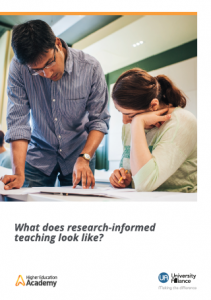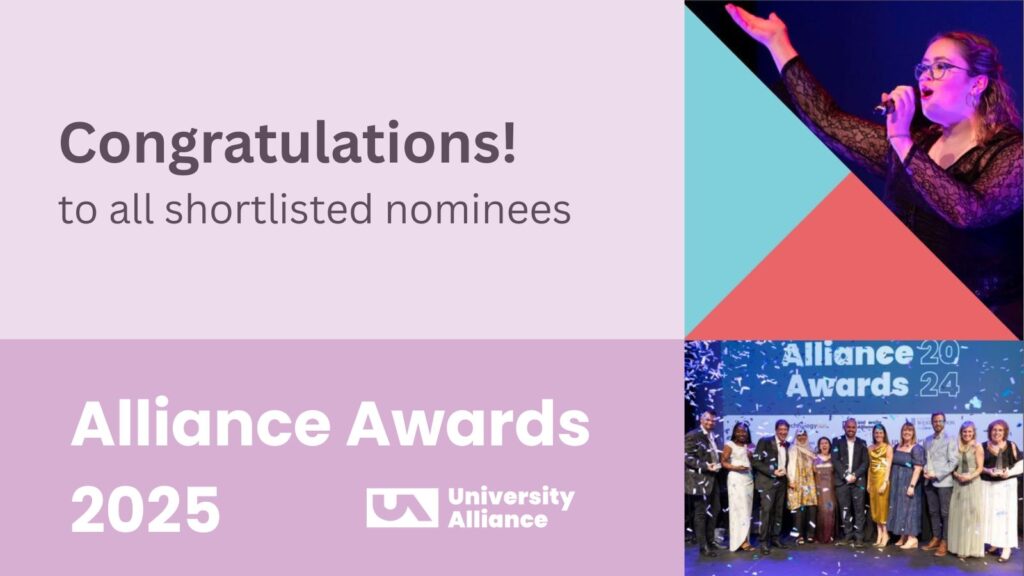 Excellent teaching goes hand in hand with excellent research. This blog prepared by the Higher Education Academy (HEA) and University Alliance, ahead of its workshop event with senior university practitioners and key higher education stakeholders, explores the latest thinking on research-informed teaching and what it looks like. Diversity is a strength of our higher education sector – and research-informed teaching can vary widely. Promoting excellent teaching whatever its form enhances the student experience, improves student employability and enriches the research culture.
Excellent teaching goes hand in hand with excellent research. This blog prepared by the Higher Education Academy (HEA) and University Alliance, ahead of its workshop event with senior university practitioners and key higher education stakeholders, explores the latest thinking on research-informed teaching and what it looks like. Diversity is a strength of our higher education sector – and research-informed teaching can vary widely. Promoting excellent teaching whatever its form enhances the student experience, improves student employability and enriches the research culture.
Read the full What does research-informed teaching look like? booklet here.
Research-informed teaching can take different forms. Examples include:
- research-led – where students are taught research findings in their field of study;
- research-oriented – where students learn research processes and methodologies;
- research-tutored – where students learn through critique and discussion between themselves and staff; and
- research-based learning – where students learn as researchers.
As the following case studies indicate, RIT offers many benefits to students, staff and higher education institutions as a whole. The case studies from Portsmouth University and Nottingham Trent University show that treating students as co-researchers supports student engagement within and beyond the formal curriculum, furthering knowledge and understanding, and in some cases contributing to the broader discipline. Such an approach can also increase student satisfaction, creating a sense of belonging to an institutional and/or disciplinary research culture and developing intellectual curiosity as well as research and communication skills. The Nottingham Trent case study also suggests that the experience has directly impacted on student performance.
RIT has also been found to support student employability, with the rise of work-based learning giving students the opportunity to participate and contribute through experiential learning, working as researchers on real world projects. The case study from Kingston University shows that this can then have wider benefits when students share their workplace experiences with peers.
Successful approaches to RIT, as the University of Lincoln case study demonstrates, focus on curriculum design, where students learn together with staff through joint activities and projects and are supported by structured interventions throughout their course, from year-one to the final-year project. However, challenges in implementing such an approach include a lack of support from the department or institution; the number and diversity of students requiring flexibility and adaptability; staff perceptions of their role and the feasibility of RIT; as well as difficulties faced by teaching-only practitioners in developing their own research.
To identify and recognise excellence in teaching many have argued for a Scholarship of Teaching and Learning (SoTL) – a model used in higher education to reflect on, and transform, teaching and learning practices (see University of Salford case study). SoTL focuses on the teaching and learning
strategies that underpin the curriculum, and promotes research-informed teaching. However, this approach has proved controversial and not everyone is convinced that it is the best way to promote excellent teaching. On the one hand, it has been championed for developing undergraduate research, providing a safe environment for early career academics to build their research experience and increasing student engagement. On the other, it has been criticised for a lack of definition and rigour, ethical issues around the power dynamic in staff-student collaborations, and having limitations for teaching-only practitioners who cover teaching for research-focused colleagues at the expense of their own scholarly development.
The case studies presented here seek to highlight the many different manifestations of research-informed teaching and to provoke discussion on how RIT can be used to support teaching excellence today.
Bibliography
Beaumont, C., O’Doherty, M. & Shannon, L. (2011) Reconceptualising Assessment Feedback: A Key to Improving Student Learning? Studies in Higher Education. 36 (6) 671-687
Bossio et al (2014) A Roadmap for Forming Successful Interdisciplinary Research Collaborations: A Reflective Approach. Higher Education Research and Development. 33 (2) 198-211
Collis, B. & Moonen, J. (2011) Flexibility in Higher Education: Revisiting Expectations. Communicar. English Ed. 19 (37) 15
Cook-Sather, A. (2013) Student-Faculty Partnership in Explorations of Pedagogical Practice: A Threshold Concept in Academic Development. International Journal for Academic Development. 19 (3) 186-98
Fanghanel, J. et al (2016) Defining and supporting the Scholarship of Teaching and Learning (SoTL): A sector wide study. The Higher Education Academy. https://www.heacademy.ac.uk/resource/defining-and-supporting-scholarship-teaching-and-learning-sotl-sector-wide-study [Accessed: 23/8/16]
Healey, M., Flint, A. & Harrington, K. (2014) Engagement Through Partnership: Students as Partners in Learning and Teaching in Higher Education. The Higher Education Academy. https://www.heacademy.ac.uk/system/files/resources/engagement_through_partnership.pdf [Accessed: 23/8/16]
Healey, M., Jenkins, A. & Lea, J. (2014) Developing Research-Based Curricula in College-Based Higher Education. The Higher Education Academy. https://www.heacademy.ac.uk/system/files/resources/developing_research-based_curricula_in_cbhe_14.pdf [Accessed: 23/8/16]
Hoskins, S. & Mitchell, J. (2015) Innovative Pedagogies Series: Research-based Learning, Taking it a Step Further. The Higher Education Academy. https://www.heacademy.ac.uk/system/files/sherria_hoskins_final.pdf [Accessed:23/8/16]
Jenkins, A, Healey, M, and Zetter, R (2007) Linking Teaching and Research in Disciplines and Departments, The Higher Education Academy: York.
Kanuka, H. (2011) Keeping the Scholarship in the Scholarship of Teaching and Learning. International Journal for the Scholarship of Teaching and Learning 5 (1) Article 3.
Kettle, J. (2013) Flexible Pedagogies: Employer Engagement and Work-Based Learning. The Higher Education Academy. https://www.heacademy.ac.uk/system/files/resources/ee_wbl_report.pdf [Accessed: 23/8/16]
Probert, B. (2013) Teaching-Focused Academic Appointments in Australian Universities: Recognition, Specialisation, or Stratification? Sydney Office for Learning and Teaching
Rowlett et al (2012) Characteristics of Excellence in Undergraduate Research (COEUR). Washington DC Council on Undergraduate Research
Russell Group (2014). ‘A Passion for Learning: The Student Experience at Russell Group Universities’ http://russellgroup.ac.uk/policy/publications/a-passion-for-learning-the-student-experience-at-russell-group-universities/ [Accessed: 23/8/16]
Scanlon, E. (2014) Scholarship in the Digital Age: Open Educational Resources, Publication and Public Engagement. British Journal of Educational Technology. 45 (1) 12-23
Stoakes, G. & Cooper, P. (2012). ‘Visualising the Research-Teaching Nexus’. In A. Miller, J. Sharp & J. Strong (Eds) What is Research-Led Teaching? Multi-Disciplinary Perspectives GuildHE CREST: London




